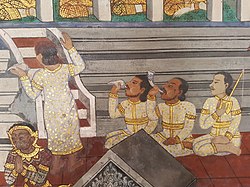Conch Shell with a Figure of Hevajra
A royal temple like Banteay Chhmar was built for performing rituals and to honor images of gods, Buddhas, and other sacred or enlightened beings for the sake of the kingdom's protection and ongoing prosperity. Conch shells were blown at the start of rituals to make the sound corresponding to the syllable om.
The dancing figure of Hevajra, a Buddhist being of enlightenment with eight heads, sixteen arms, and four legs, has been worked into the bronze embellishment of the shell. Hevajra was elevated to a prominent position in Khmer Buddhism of the Angkorian period as the standard figure denoting the practice of rituals prescribed in a text called the Hevajra-tantra. The tripod stand with three serpents is probably not original to the shell.
Relevante Bilder
Relevante Artikel
SchneckenhornSchneckenhorn, auch Schneckentrompete, ist eine aus dem Schneckenhaus einer großen Meeresschnecke gefertigte Naturtrompete, die seit der Jungsteinzeit für religiöse Rituale, als Signalinstrument vom Militär und von Fischern und seltener in der Musik verwendet wird. Die Bezeichnungen Muschelhorn oder Muscheltrompete sind irreführend, da es sich bei keiner Art zoologisch um Muscheln handelt. Instrumentenkundlich ist es ein Blechblasinstrument, da sein Ton mit den vibrierenden Lippen gebildet wird, vielleicht das älteste. Schneckenhörner werden längs oder quer geblasen, manche besitzen ein Mundstück aus Metall oder Holz und sind mit Gravuren oder Metallfassungen dekoriert. .. weiterlesen






















